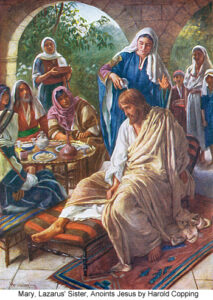
For centuries people have debated whether Mary of Bethany, the sister of Lazarus and Martha, is the same person as Mary Magdalene. This is called “the conflation of the Marys”. Supposedly Pope Gregory said they were the same woman in a sermon, confusing everyone for centuries thereafter. But no, people thought they were the same woman before his sermon. The Eastern Orthodox Church believes and teaches that Mary of Bethany and Mary Magdalene are two separate women, but the Catholics said they were the same for over a millennia.
Margaret Starbird asserts they are the same person and indeed the Secret Gospel of Mark, the Gospel of John, and more recently an early 20th century Catholic Encyclopedia(!) imply or state they are indeed the same woman.
Here is a recent post by Margaret Starbird explaining why she believes they are the same woman.
Quoting an article we were discussing on the GoddessChristians forum:
|     37. | And there was a woman in the city who was a sinner; and when she learned that He was reclining at the table in the Pharisee’s house, she brought an alabaster vial of perfume, | ||||||||||||||
| 38. | and standing behind Him at His feet, weeping, she began to wet His feet with her tears, and kept wiping them with the hair of her head, and kissing His feet and anointing them with the perfume.
Remember that  an “unnamed woman†had anointed Jesus in Mark 14 (written c. 70) and Matthew 26 (written c. 80), a woman with “an alabaster jar†of pure (precious) perfume (nard) came to Jesus at a banquet and anointed his head….and the apostles complained about the wasted value of the perfume. Jesus this says, “She has done me a favor.  She has anointed me in advance for my burial, and wherever this story is told, it will be told in memory of her.† He links this anointing (an ancient rite associated with the messiah and his marriage to the land and people through the action of the “Brideâ€). So Luke, writing in about 80-85) retells (and embellishes!) the story of the unnamed woman with the “alabaster jar†—and calls her a sinner!  He also takes the story away from Bethany and Holy Week and places it in an unnamed town much earlier in Jesus’ ministry, I believe in an attempt to downplay the importance of the action of the woman who anointed the head of Jesus in the earlier Gospels. So now we come to the Gospel of John, written a few years after Luke.  John is trying to correct Luke’s version of this story.  It is most improbable that an anointing of Jesus by a woman happened more than once, since a woman touching a Jewish man in public is an absolute “tabooâ€â€”as in NO chance!!  All four Gospel authors are dealing with a story that has been “told and retold†in their community for an entire generation about a woman who anointed Jesus at a banquet….probably just shortly before his Crucifixion and probably in Bethany, on the Mount of Olives, an extremely important location in Jewish prophetic tradition.  And John’s version is extremely explicit.  In John 11:2 and again in 12.3, the author states that “it was Mary who anointed Jesus and wiped his feet with her hair.† Clearly this is a detail (outrageous action on the part of Mary, in light of the “tabooâ€) that occurs in Luke’s Gospel and is repeated here.  Then, in chapter 12:3, the author of John’s Gospel repeats the story, in case we missed it the first time:
We can see that “John†has taken the original story and has now named the woman with the ointment who anointed Jesus —she is Mary, the sister of Lazarus. And, when Judas complains, Jesus says, “Let her keep it for the day of my burialâ€!  Again, Jesus associates the action with the ancient “heiros games†rites of the sacrificed Bridegroom and his Bride, the woman who anoints the King.  Luke’s version is the anomaly. The other three accounts agree that the woman who anointed Jesus was the “ointment bearer†at the banquet and at the tomb.  Yet WHICH Mary carries the ointment at the tomb?  Invariably, it is the one called “the Magdalene,†an extremely significant title that associates her with the prophecy of the Magdal-eder, crying at the tomb of the deceased King and being sent, defiled and defamed, into foreign exile!  “Why are you crying?†the Daughter of Sion/Magdal-eder is asked (Micah 4); the words are repeated at the tomb of Jesus n John 21, again, not once but twice:  “Why are you crying?† It is the role of the bereaved Bride to return to the tomb of her beloved and to find him resurrected in the Garden….  Where have we heard this story before?
Â
I believe it’s time to correct the record! The “conflation” of Mary of Bethany and Mary Magdalene was NOT a later construct based on a sermon by Pope Gregory in 592. It was the original understanding of the community who knew Jesus and Mary, the one whom they gave the title “H Magdalhnh.† For more information, please visit my website article about this title:    http://margaretstarbird.net/mary_called_magdalene.html    Â
Â
In memory of Her,
Margaret
“The Woman with the Alabaster Jarâ€
Â
|